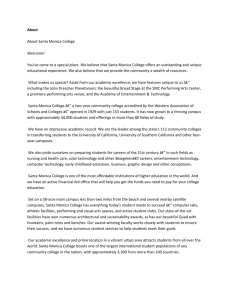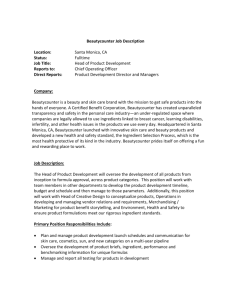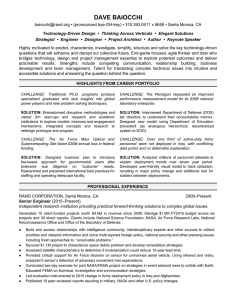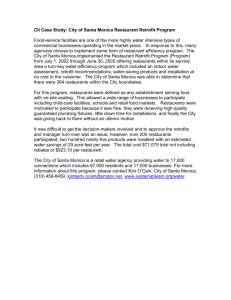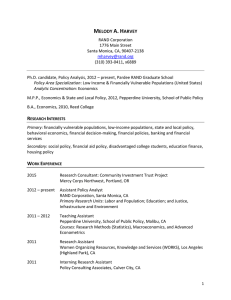REFERENCES
advertisement
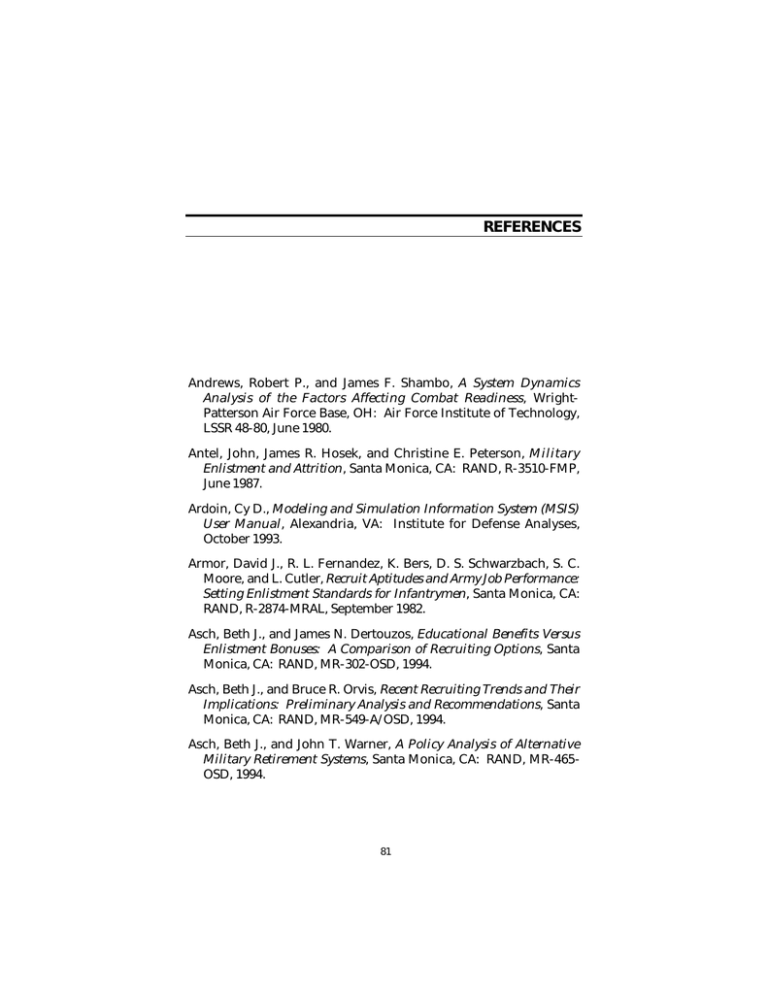
REFERENCES Andrews, Robert P., and James F. Shambo, A System Dynamics Analysis of the Factors Affecting Combat Readiness, WrightPatterson Air Force Base, OH: Air Force Institute of Technology, LSSR 48-80, June 1980. Antel, John, James R. Hosek, and Christine E. Peterson, Military Enlistment and Attrition, Santa Monica, CA: RAND, R-3510-FMP, June 1987. Ardoin, Cy D., Modeling and Simulation Information System (MSIS) User Manual, Alexandria, VA: Institute for Defense Analyses, October 1993. Armor, David J., R. L. Fernandez, K. Bers, D. S. Schwarzbach, S. C. Moore, and L. Cutler, Recruit Aptitudes and Army Job Performance: Setting Enlistment Standards for Infantrymen, Santa Monica, CA: RAND, R-2874-MRAL, September 1982. Asch, Beth J., and James N. Dertouzos, Educational Benefits Versus Enlistment Bonuses: A Comparison of Recruiting Options, Santa Monica, CA: RAND, MR-302-OSD, 1994. Asch, Beth J., and Bruce R. Orvis, Recent Recruiting Trends and Their Implications: Preliminary Analysis and Recommendations, Santa Monica, CA: RAND, MR-549-A/OSD, 1994. Asch, Beth J., and John T. Warner, A Policy Analysis of Alternative Military Retirement Systems, Santa Monica, CA: RAND, MR-465OSD, 1994. 81 82 Relating Resources to Personnel Readiness Betts, Richard K., Military Readiness: Concepts, Choices, Consequences, Washington, DC: Brookings Institution, 1995. Buddin, Richard, The Role of Service Experience in Post-Training Attrition in the Army and Air Force, Santa Monica, CA: RAND, R-2682-MRAL, November 1981. Buddin, Richard, D. S. Levy, J. M. Hanley, and D. M. Waldman, Promotion Tempo and Enlisted Retention, Santa Monica, CA: RAND, R-4135-FMP, 1992. Buddin, Richard, and Christina Witsberger, Reducing the Air Force Male Enlistment Requirement: Effects on Recruiting Prospects of the Other Services, Santa Monica, CA: RAND, R-3265-AF, March 1985. Burnam, M. Audrey, L. S. Meredith, C. D. Sherbourne, R. B. Valdez, and G. Vernez, Army Families and Soldier Readiness, Santa Monica, CA: RAND, R-3884-A, 1992. Campbell, Charlotte H., et al., A Model of Family Factors and Individual and Unit Readiness: Literature Review, Alexandria, VA: U.S. Army Research Institute for the Behavioral and Social Sciences, ARI Research Note 91-30, February 1991. Clay-Mendez, Deborah, et al., Balancing Accession and Retention, Alexandria, VA: Center for Naval Analyses, CNS 1176, September 1982. Collins, John M., Military Preparedness: Principles Compared with U.S. Practices, Washington, DC: Congressional Research Service, CRS Report for Congress 94-48 S, January 21, 1994. Congressional Budget Office, An Analysis of the President’s Budgetary Proposals for Fiscal Year 1995, Washington, DC, April 1994. Congressional Budget Office, Trends in Selected Indicators of Military Readiness, 1980 Through 1993, Washington, DC, March 1994. Cook, Alvin A., Jr., Occupational Choice, the Draft, and the Excess Supply of Air Force Volunteers, Santa Monica, CA: RAND, P-4606-1, November 1971. References 83 Cook, Alvin A., Jr., Quality Adjustment and the Excess Supply of Air Force Volunteers, Santa Monica, CA: RAND, P-4711, September 1971. Cook, A. A., Jr., and C. M. Rutherford, A Computer Program and Model for Predicting the Supply of Air Force Volunteers, Santa Monica, CA: RAND, R-910-PR, May 1972. Cook, Alvin A., Jr., and John P. White, Estimating the Quality of Airmen Recruits, Santa Monica, CA: RAND, P-4763, January 1972. Cotterman, Robert F., Forecasting Enlistment Supply: A Time Series of Cross Sections Model, Santa Monica, CA: RAND, R-3252-FMP, July 1986. Curtin, Neal P., Military Readiness: Current Indicators Need to Be Expanded for a More Comprehensive Assessment, Washington, DC: United States General Accounting Office, T-NSIAD-94-160, April 21, 1994. “Defense Department Special Briefing with Secretary of Defense William Perry and Joint Chiefs of Staff Chairman John Shalikashvili on Quality of Life Initiatives in the Military,” Federal News Reuter Transcript Service, November 10, 1994. Defense Science Board, Report of the Defense Science Board Task Force on Readiness, Washington, DC: Department of Defense, 94S-2378, June 15, 1994. Dertouzos, James N., The Effects of Military Advertising: Evidence from the Advertising Mix Test, Santa Monica, CA: RAND, N-2907FMP, March 1989. Dertouzos, James N., and Joseph E. Nation, Manpower Structure and Policies in the United States and NATO Europe, Santa Monica, CA: RAND, P-7608, January 1990. Dertouzos, James N., J. M. Polich, A. Bamezai, and T. W. Chesnutt, Recruiting Effects of Army Advertising, Santa Monica, CA: RAND, R-3577-FMP, January 1989. DeVany, Arthur S., Thomas R. Saving, and William F. Shughart, Supply Rate and Equilibrium Inventory of Air Force Enlisted 84 Relating Resources to Personnel Readiness Personnel: A Simultaneous Model of the Accession and Retention Markets Incorporating Force Level Constraints, Brooks Air Force Base, TX: Air Force Human Resources Laboratory, AFHRL-TR-7810, May 1978. Dombyl, Karen N., Unit Cohesion and Readiness: Implications for the Navy, Alexandria, VA: Center for Naval Analyses, CRM 87-110, September 1987. Fernandez, Richard L., and Jeffrey B. Garfinkle, Setting Enlistment Standards and Matching Recruits to Jobs Using Job Performance Criteria, Santa Monica, CA: RAND, R-3067-MIL, January 1985. Fernandez, Richard L., Glenn A. Gotz, and Robert M. Bell, The Dynamic Retention Model, Santa Monica, CA: RAND, N-2141-MIL, April 1985. Frankel, Oliver L., Robert A. Butler, and Margaret CarpenterHuffman, Army Manpower Cost System (AMCOS): Active Enlisted Force Prototype, Arlington, VA: U.S. Army Research Institute for the Behavioral and Social Sciences, Technical Report 709, March 1986. GRC International, Inc., The Active Army Enlisted System Strength Management Decision Support System: Analyst’s Training Course, Manual, Vienna, VA, November 1, 1995. Gabriel, Charles A., et al., A Report On Military Capabilities and Readiness for United States Senator John S. McCain, February 7, 1995. Gorham, W., Factors Affecting the Experience Composition of Airmen in USAF Job Categories: A Mathematical Approach, Santa Monica, CA: RAND, RM-2144, January 30, 1958. Gotz, Glenn A., and John J. McCall, A Dynamic Retention Model for Air Force Officers: Theory and Estimates, Santa Monica, CA: RAND, R-3028-AF, December 1984. Gotz, Glenn A., and John J. McCall, Estimating Military Personnel Retention Rates: Theory and Statistical Method, Santa Monica, CA: RAND, R-2541-AF, June 1980. References 85 Gotz, Glenn A., and Richard E. Stanton, Modeling the Contribution of Maintenance Manpower to Readiness and Sustainability, Santa Monica, CA: RAND, R-3200-FMP, January 1986. Grissmer, David W., and Judith C. Fernandez, Meeting Occupational and Total Manpower Requirements at Least Cost: A Nonlinear Programming Approach, Santa Monica, CA: RAND, P-7123, July 1985. Grissmer, David W., Sheila Nataraj Kirby, and Man-bing Sze, Factors Affecting Reenlistment of Reservists: Spouse and Employer Attitudes and Perceived Unit Environment, Santa Monica, CA: RAND, R-4011-RA, 1992. Hall, Gaineford J., Jr., and S. Craig Moore, Uncertainty in Personnel Force Modeling, Santa Monica, CA: RAND, N-1842-AF, April 1982. Halvorson, Colin O., “Readiness Baseline,” briefing, Logistics Management Institute, McLean, VA, 1995. Holz, Betty W., and Paul D. Phillips, Improved Models to Measure Army Personnel Readiness, McLean, VA: Research Analyses Corporation, Technical Paper RAC-TP-381, November 1969. Horowitz, Stanley A., and Norma J. Hibbs, Relating Resources to Readiness, Alexandria, VA: Center for Naval Analyses, CNR 1, September 1979. Hosek, James R., John Antel, and Christine E. Peterson, Who Stays, Who Leaves? Attrition Among First-Term Enlistees, Santa Monica, CA: RAND, N-2967-FMP, May 1989. Hosek, James R., C. E. Peterson, J. VanWinkle, and H. Wong, A Civilian Wage Index for Defense Manpower, Santa Monica, CA: RAND, R-4190-FMP, 1992. Hudson, Neff, “This One’s For You: Perry’s Package Would Put More Money In Your Pocket,” Air Force Times, November 21, 1994, p. 14. Hunt, Thomas R., An Analysis of Proposed Changes to the U.S. Marine Corps Permanent Change of Station Policy: The Fiscal and Readiness Impacts, Thesis, Naval Postgraduate School, Monterey, CA, March 1994. 86 Relating Resources to Personnel Readiness James, Ulysses S., et al., A Study of Systems Tools for Army Personnel Management, Alexandria, VA: U.S. Army Research Institute for the Behavioral and Social Sciences, Research Note 83-48, December 1983. Jaquette, David L., and Gary R. Nelson, The Implications of Manpower Supply and Productivity for the Pay and Composition of the Military Force: An Optimization Model, Santa Monica, CA: RAND, R-1451-ARPA, July 1974. Jaquette, D. L., G. R. Nelson, and R. J. Smith, An Analytic Review of Personnel Models in the Department of Defense, Santa Monica, CA: RAND, R-1920-ARPA, September 1977. Jones, G. T., Army Turbulence and Strategic Readiness, 1992, Carlisle Barracks, PA: U.S. Army War College, DTIC-AD-A264 234, April 15, 1993. Kawata, Jennifer H., David W. Grissmer, and Richard Eisenman, The Reserve Force Policy Screening Model (POSM): A User’s Manual, Santa Monica, CA: RAND, R-3701-JCS/RA/FMP, June 1989. Kerce, Elyse W., Quality of Life in the U.S. Marine Corps, San Diego, CA: Navy Personnel Research and Development Center, NPRDCTR-95-4, January 1995. Kohler, Daniel F., Using Survivor Functions to Estimate OccupationSpecific Bonus Effects, Santa Monica, CA: RAND, March 1988. Kralj, Mary M., Robert Sadacca, and Charlotte H. Campbell, Definition and Measures of Individual and Unit Readiness and Family Phenomena Affecting It, Alexandria, VA: U.S. Army Research Institute for the Behavioral and Social Sciences, ARI Research Note 91-32, February 1991. Larson, Eric V., and Adele R. Palmer, The Decisionmaking Context in the U.S. Department of the Navy: A Primer for Cost Analysts, Santa Monica, CA: RAND, MR-255-PA&E, 1994. Lockman, Robert F., A Model for Predicting Recruit Losses, Arlington, VA: Center for Naval Analyses, Professional Paper No. 163, 4 September 1976. References 87 Lockman, Robert F., and Patrice L. Gordon, A Revised Screen Model for Recruit Selection and Recruitment Planning, Arlington, VA: Center for Naval Analyses, CRC 338, August 1977. Marquis, M. Susan, and Sheila Nataraj Kirby, Economic Factors in Reserve Attrition: Prior Service Individuals in the Army National Guard and Army Reserve, Santa Monica, CA: RAND, R-3686-1-RA, March 1989. Massey, H. G., Introduction to the USAF Total Force Cost Model, Santa Monica, CA: RAND, R-2098-AF, June 1977. Matlick, Richard K., et al., Cost and Training Effectiveness Analysis in the Army Life Cycle Systems Management Models, Washington, DC: U.S. Army Research Institute for the Behavioral and Social Sciences, Technical Report 503, July 23, 1980. Maxfield, Thomas R., A Regression Model of the Effects of Personnel Characteristics on Aviation Readiness and Productivity, Thesis, Naval Postgraduate School, Monterey, CA, December 1985. Miller, Sidney H., Laura Critchlow Sammis, and Herbert J. Shukiar, The Officer Force Progression Model: A Steady-State Mathematical Model of the U.S. Air Force Officer Structure, Santa Monica, CA: RAND, R-1607-PR, November 1974. Moore, S. Craig, J. A. Stockfisch, M. S. Goldberg, S. M. Holroyd, and G. G. Hildebrandt, Measuring Military Readiness and Sustainability, Santa Monica, CA: RAND, R-3842-DAG, 1991. Mooz, W. E., and K. P. Heinze, The Air Reserve Forces Study, Vol. X: Cost Analysis Methods and Procedures, Santa Monica, CA: RAND, RM-5335-PR, October 1967. Nakada, Michael K., A Dynamic Model of Navy Enlisted Retention, San Diego, CA: Navy Personnel Research and Development Center, NPRDC TR 84-20, February 1984. National Defense Research Institute, Assessing the Structure and Mix of Future Active and Reserve Forces: Final Report to the Secretary of Defense (Executive Summary), Santa Monica, CA: RAND, MR140/2-OSD, 1993. 88 Relating Resources to Personnel Readiness North, James H., et al., Perspectives on Minority Officer Success Rates in the Marine Corps, Alexandria, VA: Center for Naval Analyses, June 1994. Orvis, Bruce R., H. J. Shukiar, Laurie McDonald, M. J. Mattock, M. R. Kilburn, and M. G. Shanley, Ensuring Personnel Readiness in the Army Reserve Components, Santa Monica, CA: RAND, MR-659-A, 1996. Orvis, Bruce R., Michael T. Childress, and J. Michael Polich, Effect of Personnel Quality on the Performance of Patriot Air Defense System Operators, Santa Monica, CA: RAND, R-3901-A, 1992. Orvis, Bruce R., Martin T. Gahart, and Alvin K. Ludwig, Validity and Usefulness of Enlistment Intention Information, Santa Monica, CA: RAND, R3775-FMP, 1992. Palmer, Adele R., Cost Factors in the Army: Vol. 1, The Decisionmaking Context, Santa Monica, CA: RAND, R-4078/1-PA&E, 1992. Palmer, Adele R., J. H. Bigelow, J. G. Bolten, D. Dizengoff, J. H. Kawata, H. G. Massey, R. L. Petruschell, and M. G. Shanley, Assessing the Structure and Mix of Future Active and Reserve Forces: Cost Estimation Methodology, Santa Monica, CA: RAND, MR-1341-OSD, 1992. Palmer, Adele R., and Eric V. Larson, Cost Factors in the Army: Vol. 2, Factors, Methods, and Models, Santa Monica, CA: RAND, R-4078/2-PA&E, 1992. Palmer, Adele R., and C. Peter Rydell, Developing Cost-Effectiveness Guidelines for Managing Personnel Resources in a Total Force Context: Executive Summary, Santa Monica, CA: RAND, R-4005/2-FMP, 1991. Palmer, Adele R., and C. Peter Rydell, An Integrative Modeling Approach for Managing the Total Defense Labor Force, Santa Monica, CA: RAND, R-3756-OSD/AF, December 1989. Petruschell, Robert L., James H. Bigelow, and Joseph G. Bolten, Overview of the Total Army Design and Cost System, Santa Monica, CA: RAND, MR-195-A, 1993. References 89 Polich, J. Michael, James N. Dertouzos, and S. James Press, The Enlistment Bonus Experiment, Santa Monica, CA: RAND, R-3353FMP, April 1986. Press, S. James, Using the Pise Criterion to Measure the Effects of Imbalance in the Analysis of Covariance, Santa Monica, CA: RAND, N-1890-MRAL, February 1983. Quester, Aline, et al., National Manpower Inventory Final Report: Vols. I-III, Main Text, Technical Appendixes, Technical Documentation for Software for the Model, Alexandria, VA: Center for Naval Analyses, CRC 533, September 1985. Richards, Laurence D., Peter L. Eirich, and Murray A. Geisler, A Concept for the Management of Readiness, Washington, DC: Logistics Management Institute, January 1980. Roane, Peter, Norma J. Hibbs, and Stanley A. Horowitz, A Partial Review of the Literature Relating Resource Use to Readiness, Arlington, VA: Center for Naval Analyses, (CNA)78-1128.10, August 15, 1978. Roos, John G., “Redefining Readiness,” Armed Forces Journal International, October 1994, pp. 33–42. Rosenberg, Eric, “Grounding of Navy Jets Has Resulted in Worst Readiness Rating,” Defense Week, December 5, 1994, p. 1. Rosenberg, Eric, “Keeping Readiness High in the Navy Is a Concern,” Defense Week, December 5, 1994, p. 7. Rosenberg, Eric, “More Chinks in the Armor for Navy Aviation Readiness,” Defense Week, December 12, 1994, p. 3. Rosenberg, Eric, “Navy Has Plan to Predict Downturns in Readiness,” Defense Week, December 12, 1994, p. 6. Rostker, Bernard, Air Reserve Personnel Study: Volume III, Total Force Planning, Personnel Costs, and the Supply of New Reservists, Santa Monica, CA: RAND, R-1430-PR, October 1974. Rydell, C. Peter, Adele R. Palmer, and David J. Osbaldeston, Developing Cost-Effectiveness Guidelines for Managing Personnel 90 Relating Resources to Personnel Readiness Resources in a Total Force Context, Santa Monica, CA: RAND, R-4005/1-FMP, 1991. Sadacca, Robert, Rodney A. McCloy, and Ani S. DiFazio, The Impact of Army and Family Factors on Individual Readiness, Alexandria, VA: U.S. Army Research Institute for the Behavioral and Social Sciences, Research Report 1643, August 1993. Shishko, Robert, and Robert M. Paulson, Relating Resources to the Readiness and Sustainability of Combined Arms Units, Santa Monica, CA: RAND, R-2769-MRAL, December 1981. Thompson, Theodore J., Iosif A. Krass, and Timothy T. Liang, Quantifying the Impact of the Permanent Change of Station (PCS) Budget on Navy Enlisted Personnel Unit Readiness, San Diego, CA: Navy Personnel Research and Development Center, TN-91-16, June 1991. United States Department of Defense, Office of the Assistant Secretary of Defense, Family Status and Initial Term of Service: Vol. I, Summary, Washington, DC: December 1993. United States Department of Defense, Office of the Assistant Secretary of Defense, Family Status and Initial Term of Service: Vol. II, Trends and Indicators, Washington, DC, December 1993. United States Department of Defense, Office of the Assistant Secretary of Defense, Family Status and Initial Term of Service: Vol. III, Field Study, Washington, DC, December 1993. United States Department of Defense, Office of the Assistant Secretary of Defense, Family Status and Initial Term of Service: Vol. IV, Appendices, Washington, DC, December 1993. United States Department of Defense, Personnel Office of the Deputy Chief of Staff for Military Strength Analysis and Forecasting, Information Briefing for Manpower and Personnel Executives, Washington, DC, September 8, 1995. United States General Accounting Office, 1995 Budget: Potential Reductions to the Operation and Maintenance Programs, Washington, DC, GAO/NSIAD-94-246BR, September 1994. References 91 United States General Accounting Office, DOD Budget: Selected Categories of Planned Funding for Fiscal Years 1995–99, Washington, DC, GAO/NSIAD-95-92, February 1995. United States General Accounting Office, DOD Force Mix Issues: Greater Reliance on Civilians in Support Roles Could Provide Significant Benefits, Washington, DC, GAO/NSIAD-95-5, October 1994. United States General Accounting Office, Military Readiness, Mobilization Planning, and Civil Preparedness: Issues For Planning, Washington, DC, PLRD-81-6, February 1981. United States General Accounting Office, Military Readiness: DOD Needs to Develop a More Comprehensive Measurement System, Washington, DC, GAO/NSIAD-95-29, October 1994. United States General Accounting Office, Military Recruiting: More Innovative Approaches Needed, Washington, DC, GAO/NSIAD-9522, December 1994. Van Nostrand, Sally J., et al., Personnel Readiness Indicator Model (PRIM) Study, Bethesda, MD: U.S. Army Concepts Analysis Agency, CAA-SR-84-5, September 1984. Vernez, Georges, and Gail L. Zellman, Families and Mission: A Review of the Effects of Family Factors on Army Attrition, Retention, and Readiness, Santa Monica, CA: RAND, N-2624-A, August 1987. Vicino, E. Byars, Manpower and Training Research Information Systems (MATRIS): Summary Report, San Diego, CA: Defense Technical Information Center, 1986. Warner, John T., and Philip M. Lurie, A Simulation of a New Model of Compensation and Retention, Alexandria, VA: Center for Naval Analyses, (CNA) 79-1350, September 12, 1979. Wild, William G., and Bruce R. Orvis, Design of Field-Based Crosstraining Programs and Implications for Readiness, Santa Monica, CA: RAND, R-4242-A, 1993. Williams, Robert H., “Industry Leader Sounds Preparedness Warning,” National Defense, December 1994, p. 18.
